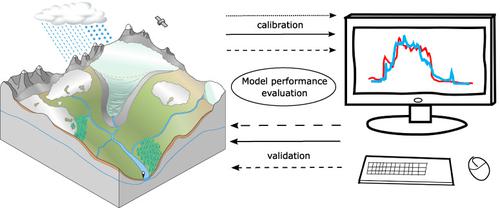当前位置:
X-MOL 学术
›
WIREs Water
›
论文详情
Our official English website, www.x-mol.net, welcomes your
feedback! (Note: you will need to create a separate account there.)
Glacio‐hydrological model calibration and evaluation
WIREs Water ( IF 6.8 ) Pub Date : 2020-09-22 , DOI: 10.1002/wat2.1483 Marit Tiel 1 , Kerstin Stahl 1, 2 , Daphné Freudiger 1 , Jan Seibert 3
WIREs Water ( IF 6.8 ) Pub Date : 2020-09-22 , DOI: 10.1002/wat2.1483 Marit Tiel 1 , Kerstin Stahl 1, 2 , Daphné Freudiger 1 , Jan Seibert 3
Affiliation

|
Glaciers are essential for downstream water resources. Hydrological modeling is necessary for a better understanding and for future projections of the water resources in these rapidly changing systems, but modeling glacierized catchments is especially challenging. Here we review a wealth of glacio‐hydrological modeling studies (145 publications) in catchments around the world. Major model challenges include a high uncertainty in the input data, mainly precipitation, due to scarce observations. Consequently, the risk of wrongly compensating input with model errors in competing snow and ice accumulation and melt process parameterization is particularly high. Modelers have used a range of calibration and validation approaches to address this issue. The review revealed that while a large part (~35%) of the reviewed studies used only streamflow data to evaluate model performances, most studies (~50%) have used additional data related to snow and glaciers to constrain model parameters. These data were employed in a variety of calibration strategies, including stepwise and multi‐signal calibration. Although the primary aim of glacio‐hydrological modeling studies is to assess future climate change impacts, long‐term changes have rarely been taken into account in model performance evaluations. Overall, a more precise description of which data are used how for model evaluation would facilitate the interpretation of the simulation results and their uncertainty, which in turn would support water resources management. Moreover, there is a need for systematic analyses of calibration approaches to disentangle what works best and why. Addressing this need will improve our system understanding and model simulations of glacierized catchments.
中文翻译:

冰川水文模型校准和评估
冰川对于下游水资源至关重要。为了更好地理解这些瞬息万变的系统中的水资源并对其进行未来的预测,必须进行水文建模,但是对冰川集水区进行建模尤其具有挑战性。在这里,我们回顾了世界各地流域的大量冰川水文模型研究(145篇出版物)。由于缺乏观测,模型的主要挑战包括输入数据的高度不确定性,主要是降水。因此,在竞争的冰雪积聚和融化过程参数化中,用模型错误错误地补偿输入的风险特别高。建模人员已使用各种校准和验证方法来解决此问题。审查显示,虽然大部分(〜35%)的审查研究仅使用流量数据评估模型性能,但大多数研究(〜50%)已使用与雪和冰川相关的其他数据来约束模型参数。这些数据已用于多种校准策略中,包括逐步校准和多信号校准。尽管冰川水文学模型研究的主要目的是评估未来的气候变化影响,但是在模型性能评估中很少考虑长期变化。总体而言,对哪些数据如何用于模型评估进行更精确的描述将有助于对模拟结果及其不确定性的解释,从而为水资源管理提供支持。此外,需要对校准方法进行系统分析,以弄清什么方法最有效以及为什么。解决这一需求将提高我们对冰川集水区的系统理解和模型模拟。
更新日期:2020-10-19
中文翻译:

冰川水文模型校准和评估
冰川对于下游水资源至关重要。为了更好地理解这些瞬息万变的系统中的水资源并对其进行未来的预测,必须进行水文建模,但是对冰川集水区进行建模尤其具有挑战性。在这里,我们回顾了世界各地流域的大量冰川水文模型研究(145篇出版物)。由于缺乏观测,模型的主要挑战包括输入数据的高度不确定性,主要是降水。因此,在竞争的冰雪积聚和融化过程参数化中,用模型错误错误地补偿输入的风险特别高。建模人员已使用各种校准和验证方法来解决此问题。审查显示,虽然大部分(〜35%)的审查研究仅使用流量数据评估模型性能,但大多数研究(〜50%)已使用与雪和冰川相关的其他数据来约束模型参数。这些数据已用于多种校准策略中,包括逐步校准和多信号校准。尽管冰川水文学模型研究的主要目的是评估未来的气候变化影响,但是在模型性能评估中很少考虑长期变化。总体而言,对哪些数据如何用于模型评估进行更精确的描述将有助于对模拟结果及其不确定性的解释,从而为水资源管理提供支持。此外,需要对校准方法进行系统分析,以弄清什么方法最有效以及为什么。解决这一需求将提高我们对冰川集水区的系统理解和模型模拟。











































 京公网安备 11010802027423号
京公网安备 11010802027423号